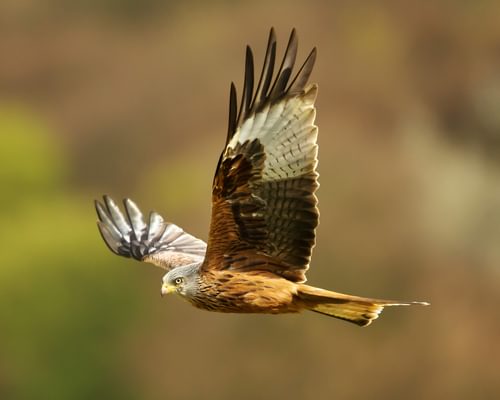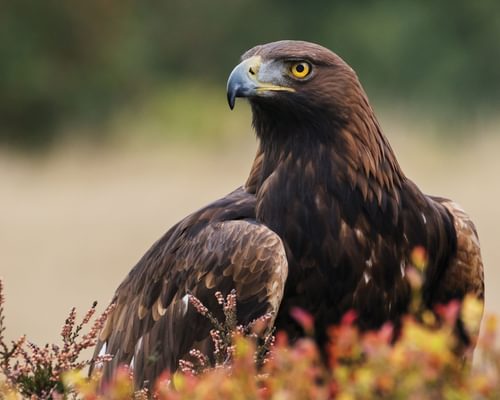Buzzard
Least ConcernButeo buteo
Visual Identification
Appearance
The Buzzard exhibits a wide variety of plumage colours, ranging from dark chocolate-brown to pale cream. Its broad wings and short, fan-shaped tail are characteristic features, and its wingspan of 113-128 cm makes it an impressive sight in flight.
Both sexes are similar in appearance, with females usually larger than males. Juveniles tend to have lighter plumage with more streaking (not barred). All Buzzards have yellow legs, a dark-tipped hooked beak, and piercing dark eyes.
Size
Length
51cm to 57cm
Wingspan
113cm to 128cm
Weight
550g to 1.2kg
Colours
Males and females have similar plumage
Primary Colour
Brown
Secondary Colour
White Black
Beak Colour
Black
Leg Colour
Yellow
Habitat and Distribution
Habitats
Woodland
Garden
Wetland
Coastal
Urban
Farmland
Grassland
Desert
Tundra
Rainforest
Mountain
Savanna
Distribution
Buzzards thrive in various habitats, including woodlands, farmland, and grasslands across Europe and parts of Asia. They prefer areas with a mix of open ground for hunting and trees for nesting and perching.
In the UK, Buzzards are now widespread, having recolonised eastern areas in recent decades. Some northern populations migrate south for winter, while others are resident year-round, depending on food availability.
Elevation Range
Sea level to 2,000 meters
Climate zones
Temperate, Subtropical
Distribution Map
This map gives you a rough idea of where you might spot a Buzzard. The coloured areas show countries where these birds have been seen.
A few things to keep in mind:
- Birds might not be everywhere in the coloured areas, for example, they may be present around the coast of that country
- Where birds live can change with seasons and available food
- This map is quite simple - it doesn't show exact locations
We're working on making our maps even better! Soon, we hope to show you:
- More detailed maps for bigger countries, including state and region
- How birds move around during different seasons
Distribution by Region
Behaviour and Ecology
Bird Attributes
This feature is in beta. We'd love your feedback to improve it!
Share your thoughtsBird Attributes Explained
Our bird attributes system rates various aspects of a bird's capabilities on a scale of 0-100, based on data from field observations, scientific studies, and expert knowledge.
Attribute Categories:
- Agility: Manoeuvrability, speed, and grace in flight or movement.
- Strength: Physical power, often correlating with size and hunting abilities.
- Adaptability: Ability to thrive in various environments or changing conditions.
- Aggressiveness: Territorial behaviour and assertiveness, particularly during breeding seasons.
- Endurance: Stamina, often seen in migration patterns or foraging behaviours.
Understanding the Ratings:
- 0-20: Very Low
- 21-40: Low
- 41-60: Average
- 61-80: High
- 81-100: Very High
Remember, these attributes are relative to other bird species and don't necessarily indicate superiority.
Hover over the icon next to each attribute for more information.
Tap the icon next to each attribute for more information.
Agility
Reflects the bird's manoeuvrability, speed, and grace in flight or movement.
The Buzzard demonstrates remarkable agility in flight, with its broad wings allowing for effortless soaring and impressive aerial displays. Their ability to perform spectacular manoeuvres during courtship, including spiraling flights and talon-grappling, showcases their high level of aerial prowess.
Strength
Indicates the bird's physical power, often correlating with size and hunting abilities.
As a medium-sized raptor, the Buzzard possesses considerable strength for its size. Its ability to carry prey and construct sturdy nests of sticks indicates good physical power. However, it's not as strong as larger birds of prey, hence the moderate rating.
Adaptability
Represents the bird's ability to thrive in various environments or changing conditions.
Buzzards exhibit exceptional adaptability, thriving in various habitats from sea level to 2,00 metres elevation. Their opportunistic diet, ranging from small mammals to carrion, and their ability to adjust to different environments, including human-altered landscapes, demonstrates their highly adaptive nature.
Aggressiveness
Measures the bird's territorial behaviour and assertiveness, particularly during breeding seasons.
While Buzzards are predators and can be territorial, especially during breeding season, they're not considered highly aggressive birds. Their preference for smaller prey and their tendency to avoid confrontation with larger raptors suggests a moderate level of aggression.
Endurance
Reflects the bird's stamina, often seen in migration patterns or foraging behaviours.
The Buzzard's ability to soar for extended periods using thermal currents indicates good endurance. Their potential to live up to 25 years in the wild, coupled with some populations undertaking seasonal migrations, further supports their high endurance rating. However, they're not known for extremely long-distance flights, which prevents a top-tier score.
Diet
Buzzards are opportunistic hunters with a varied diet. They primarily feed on small mammals, especially voles and rabbits, but also consume birds, reptiles, and large insects. During scarce times, they'll scavenge carrion, demonstrating their adaptability.
Other prey includes rodents and shrews, hares, reptiles like lizards and snakes, frogs and toads, beetles, earthworms and other invertebrates.
Behaviour
Buzzards are often seen perched prominently on poles or trees, scanning for prey. They're masters of energy conservation, frequently soaring on thermal currents with minimal wing movement.
During the breeding season, pairs perform spectacular aerial displays, including spiralling flights and talon-grappling.
Vocalisation
The Buzzard's most recognisable call is a plaintive, cat-like 'pee-yow' or 'kee-yah', often heard during territorial displays or when alarmed.
During courtship, pairs may engage in a series of high-pitched mewing calls, adding to the soundscape of European woodlands.
Nesting & Breeding
Buzzard pairs often mate for life, reinforcing their bond with impressive aerial displays in early spring. They typically breed once a year, with the season starting in March or April.
Nests are built in tall trees or on cliffs, constructed of sticks and lined with fresh leaves. The female usually lays 2-3 eggs, which are white with brown speckles.
Incubation lasts about 33-38 days, primarily by the female. Chicks fledge after 50-60 days but remain dependent on their parents for several weeks.
Lifespan
The Buzzard typically lives for 8 years, with a maximum recorded lifespan of 28.8 years.
Like all birds, lifespan can be affected by factors including predation, habitat quality, disease, and access to food sources.
Conservation and Status
Global Conservation Status
While the Buzzard is currently listed as Least Concern, it faces threats from habitat loss and illegal persecution.
In some areas, particularly in the UK, populations have recovered significantly following past declines due to pesticide use and hunting.
Birdwatching Tips
- Look for Buzzards soaring in wide circles over open countryside
- Listen for their distinctive 'mewing', cat-like call, especially during the breeding season
- Their wings form a shallow V-shape when soaring
- Observe fence posts and isolated trees in fields for perched individuals
- In the UK, they're commonly seen along motorways, utilising updrafts from traffic
Additional Information
Quick Facts
Other names:
Common Buzzard, European Buzzard, Eurasian Buzzard
Family:
AccipitridaePredators
Did You Know?
- Buzzards can live up to 25 years in the wild, making them one of the longer-lived raptor species.
- They have excellent eyesight and can spot prey over a kilometre away.
- Buzzards have been observed hunting cooperatively in pairs in some parts of their range.
- The Common Buzzard can reach speeds of up to 28 mph and fly at an average height of 400 metres - but has been known to reach heights of 1,000 metres.
Was this bird profile helpful?
Your feedback helps us improve our content
Thanks for your feedback!
Your input helps us improve our content.
Community Experience
Community Ratings
1 rating from birders
Latest Community Reviews
Ptaszek Staszek
Community Reviews
Create Your Free Account Welcome Back!
Join our community to rate birds and share your experiences. Creating an account is completely free and only takes a minute. Sign in to your account to rate birds and share your experiences with our community.
Your information is secure and will never be shared.
By creating an account, you agree to our Privacy Policy.
FAQs
Why do Buzzards call?
Buzzards call for a variety of reasons. They vocalise when chasing other Buzzards out of their territory, when alarmed by humans or predators, and when arriving back at their nest.
Why do Buzzards sit in fields?
It is not unusual to see Buzzards perched in fields, sometimes in good numbers. They are attracted by worms and other ground invertebrates, often after rain or ploughing operations.
What is a group of Buzzards called?
The collective nouns to describe a group of Buzzards are as follows:
- a flock of buzzards
- a kettle of buzzards
- a wake of buzzards
Why do Buzzards fly so high?
Buzzards can soar at heights of several hundred meters while expending very little energy. They use thermal updrafts and their large, broad wings to stay airborne for long periods while flapping their wings very little.
Like so many other birds of prey, their eyesight is extraordinary and they can watch for food from such great heights while remaining barely visible to their unsuspecting victim on the ground below.
How fast can Buzzards fly?
The Buzzard may not have the speed of hunters like the Peregrine Falcon, but they are powerful in flight nonetheless. They can reach speeds of 28 miles per hour in level flight but are much faster when swooping down on their prey. The similarly built Red-Tailed Hawk of America can reach up to 120 miles per hour when diving.
Why do Crows chase Buzzards?
Crows regularly mob Buzzards and other birds of prey to drive them away from the area. However, the tables can turn as Buzzards may catch and kill crows and other birds from the corvid family.
Can Buzzards hover?
Some Buzzards will try to perform some type of hover, but it's relatively uncommon and won't last for more than a few seconds at a time.
The most likely time you'll see a buzzard 'hovering' is when there's a headwind they can use that makes them appear stationary in the air. Some individuals develop more of a habit of doing it than others.
Similar Birds
References
- 2 3 4
website: BirdLife International. 2021. Buteo buteo. The IUCN Red List of Threatened Species 2021: e.T61695117A206634667.
View source - 1
website, 2010: Fransson et al., EURING list of longevity records for European birds
View source


